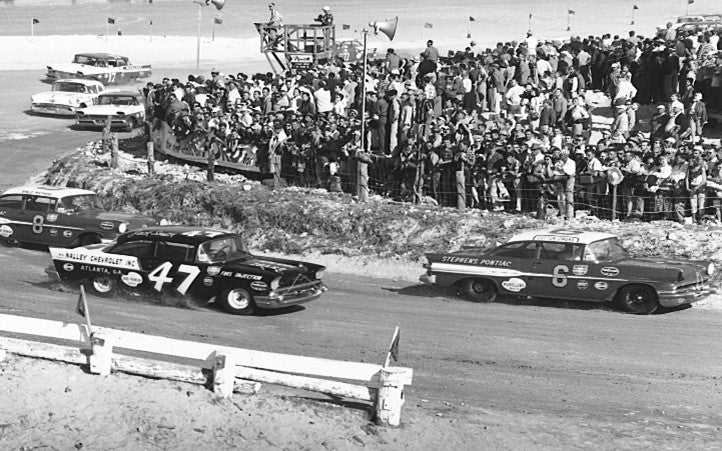
The History of Stock Car Racing
Stock car racing has a fascinating history that stretches back over a century. The roots of the sport can be traced back to the early 20th century when bootleggers in the southeastern United States began modifying their cars to outrun the police while transporting illegal alcohol during the prohibition era. No one could have predicted these events to expand into a racing sanction, as large as the modern-day sport known as NASCAR.
After prohibition was repealed in 1933, these drivers continued to modify their cars to make them faster and more agile. On the weekends, they would gather in fields or on dirt tracks to race against each other for bragging rights and small purses… I guess we could say the stockcar racing began because of some competitive kids, who would say “I bet my car is faster than yours!”
The First Official Stock Car Race

The first official stock car race took place on the sands of Daytona Beach, Florida, in 1936. It was a 3.2-mile course that consisted of a straightaway on the beach and a paved oval on the road. This event attracted a lot of attention, and it was followed by other races on the same course over the next few years. These races led Daytona to become the “World Center of Racing.”
In 1938, NASCAR founder Bill France Sr. and his brothers Jim and Danny organized a race in Daytona Beach that was open to all stock car drivers. The race was a success, and it led to the creation of the National Championship Stock Car Circuit (NCSCC), which was the forerunner to NASCAR.
The Birth of NASCAR

In 1947, Bill France Sr. organized a meeting with other stock car racing promoters to discuss the future of the sport. They agreed to form a governing body to regulate and promote the sport, which led to the formation of NASCAR. France Sr. became the first president of NASCAR, and his vision helped turn stock car racing into a professional sport.
The early days of NASCAR were challenging. The races were held on dirt tracks and makeshift circuits, and safety was not a top priority. Drivers were often injured or worse, killed in crashes, and the races were considered to be extremely dangerous. Despite this, the popularity of the sport continued to grow, and by the 1950s, NASCAR had established itself as a major racing series in the United States. Thankfully, as the sport grew so did the safety. Like anything, technological advances expanded. The future of NASCAR racers would have roll cages, seat mounts, nets in the windows, driving suits and more.
The Modern Era of Stock Car Racing
In the 1960s and 70s, stock car racing underwent significant changes. The cars became more sophisticated, and safety standards were implemented to reduce the risk of injury to the drivers. NASCAR also expanded its schedule, and races were held at larger venues, such as the Daytona International Speedway and the Talladega Superspeedway.
The 1980s and 90s were a time of great change for stock car racing. Television coverage brought the sport into the living rooms of fans across the country, and sponsorships brought in large amounts of money. Drivers such as Dale Earnhardt and Jeff Gordon became household names, and their success on the track helped to fuel the sport's growth.

Today, NASCAR is one of the most popular racing series in the world. It has a large fan base and generates billions of dollars in revenue each year. Here are a few venues and the capacity of viewers; Texas Motor Speedway holds 181,655 people, Bristol Motor Speedway can hold about 162,000 and Talladega Superspeedway can hold 160,000. On average there are at least 80,000 viewers present at NASCAR races, (not including those who view from their home on TV or listen on the radio). Thankfully the cars have become even more advanced, and safety standards continue to improve. The sport has also diversified, with races held on road courses and even outside the United States.
The history of stock car racing is filled with exciting moments, legendary drivers, and iconic races. It has grown from an underground activity into a multi-billion-dollar industry that attracts millions of fans worldwide. Whether you're a die-hard fan or a casual observer, stock car racing is a sport that has something for everyone. Its history is a testament to the tenacity and passion of the drivers, promoters, and fans who have made it what it is today.

NASCAR and the entirety of stockcar racing has greatly impacted the automotive industry. It all started with the simple modifications racers made to their car, that have turned into complete car builds with focuses on engine upgrades, suspension modifications, and aerodynamic enhancements. As a result, many companies that produce aftermarket parts for street cars have developed products that are inspired by NASCAR technology. These parts are designed to improve the performance of street cars and give them a more aggressive look, similar to the cars that race in NASCAR. This has created a multi-billion-dollar industry that caters to car enthusiasts who want to enhance the performance and appearance of their vehicles.
Not to mention all the monetary value NASCAR has brought into the car world. The Sports Business Journal stated in 2023 “They claim that NASCAR's assets make up 93% of the value of the sport, while teams' assets are only worth 7%. That's based on an assumption that the entire sport's assets could be valued at $10 billion combined, while the 36 car charters are worth $20 million each, or $720 million...” The exact value is hard to find because of all the factors, such as tickets, concession, merchandise, ads and sponsorships. However, it is a known fact that corporate sponsors pay hundreds of thousands for the exposure of their brand at a NASCAR event.
Here at Speed Gems, we like to think some of our customers are inspired by the NASCAR racers and the fast cars they race in. We are thankful our transmission adapters play a role in the modified car world, helping people to enjoy their ride!
Sources:
https://www.encyclopedia.com/media/encyclopedias-almanacs-transcripts-and-maps/stock-car-racing
https://www.britannica.com/sports/stock-car-racing
https://www.sportsbusinessjournal.com/
https://flowracers.com/blog/nascar-annual-revenue/


Leave a comment